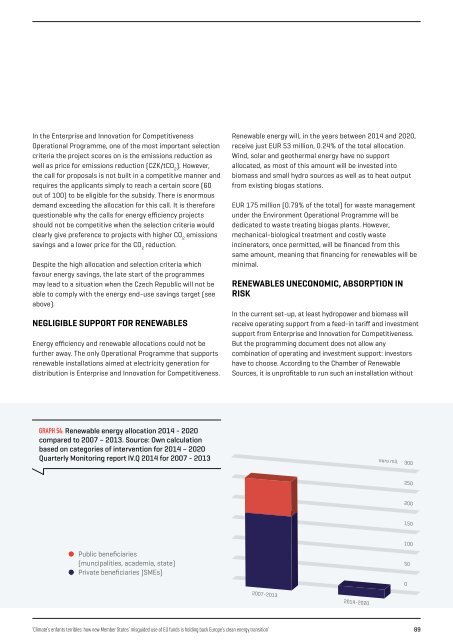ENFANTS TERRIBLES
enfants-terribles
enfants-terribles
You also want an ePaper? Increase the reach of your titles
YUMPU automatically turns print PDFs into web optimized ePapers that Google loves.
2007-2013 2014-2020<br />
In the Enterprise and Innovation for Competitiveness<br />
Operational Programme, one of the most important selection<br />
criteria the project scores on is the emissions reduction as<br />
well as price for emissions reduction (CZK/tCO 2<br />
). However,<br />
the call for proposals is not built in a competitive manner and<br />
requires the applicants simply to reach a certain score (60<br />
out of 100) to be eligible for the subsidy. There is enormous<br />
demand exceeding the allocation for this call. It is therefore<br />
questionable why the calls for energy efficiency projects<br />
should not be competitive when the selection criteria would<br />
clearly give preference to projects with higher CO 2<br />
emissions<br />
savings and a lower price for the CO 2<br />
reduction.<br />
Despite the high allocation and selection criteria which<br />
favour energy savings, the late start of the programmes<br />
may lead to a situation when the Czech Republic will not be<br />
able to comply with the energy end-use savings target (see<br />
above).<br />
NEGLIGIBLE SUPPORT FOR RENEWABLES<br />
Energy efficiency and renewable allocations could not be<br />
further away. The only Operational Programme that supports<br />
renewable installations aimed at electricity generation for<br />
distribution is Enterprise and Innovation for Competitiveness.<br />
Renewable energy will, in the years between 2014 and 2020,<br />
receive just EUR 53 million, 0.24% of the total allocation.<br />
Wind, solar and geothermal energy have no support<br />
allocated, as most of this amount will be invested into<br />
biomass and small hydro sources as well as to heat output<br />
from existing biogas stations.<br />
EUR 175 million (0.79% of the total) for waste management<br />
under the Environment Operational Programme will be<br />
dedicated to waste treating biogas plants. However,<br />
mechanical-biological treatment and costly waste<br />
incinerators, once permitted, will be financed from this<br />
same amount, meaning that financing for renewables will be<br />
minimal.<br />
RENEWABLES UNECONOMIC, ABSORPTION IN<br />
RISK<br />
In the current set-up, at least hydropower and biomass will<br />
receive operating support from a feed-in tariff and investment<br />
support from Enterprise and Innovation for Competitiveness.<br />
But the programming document does not allow any<br />
combination of operating and investment support: investors<br />
have to choose. According to the Chamber of Renewable<br />
Sources, it is unprofitable to run such an installation without<br />
GRAPH 54: Renewable energy allocation 2014 - 2020<br />
compared to 2007 – 2013. Source: Own calculation<br />
based on categories of intervention for 2014 – 2020<br />
Quarterly Monitoring report IV.Q 2014 for 2007 - 2013<br />
euro mil.<br />
300<br />
250<br />
200<br />
150<br />
Public beneficiaries<br />
(muncipalities, academia, state)<br />
Private beneficiaries )SMEs)<br />
100<br />
50<br />
0<br />
‘Climate’s enfants terribles: how new Member States’ misguided use of EU funds is holding back Europe’s clean energy transition’ 89


